1991 HONDA CIVIC key
[x] Cancel search: keyPage 4 of 136
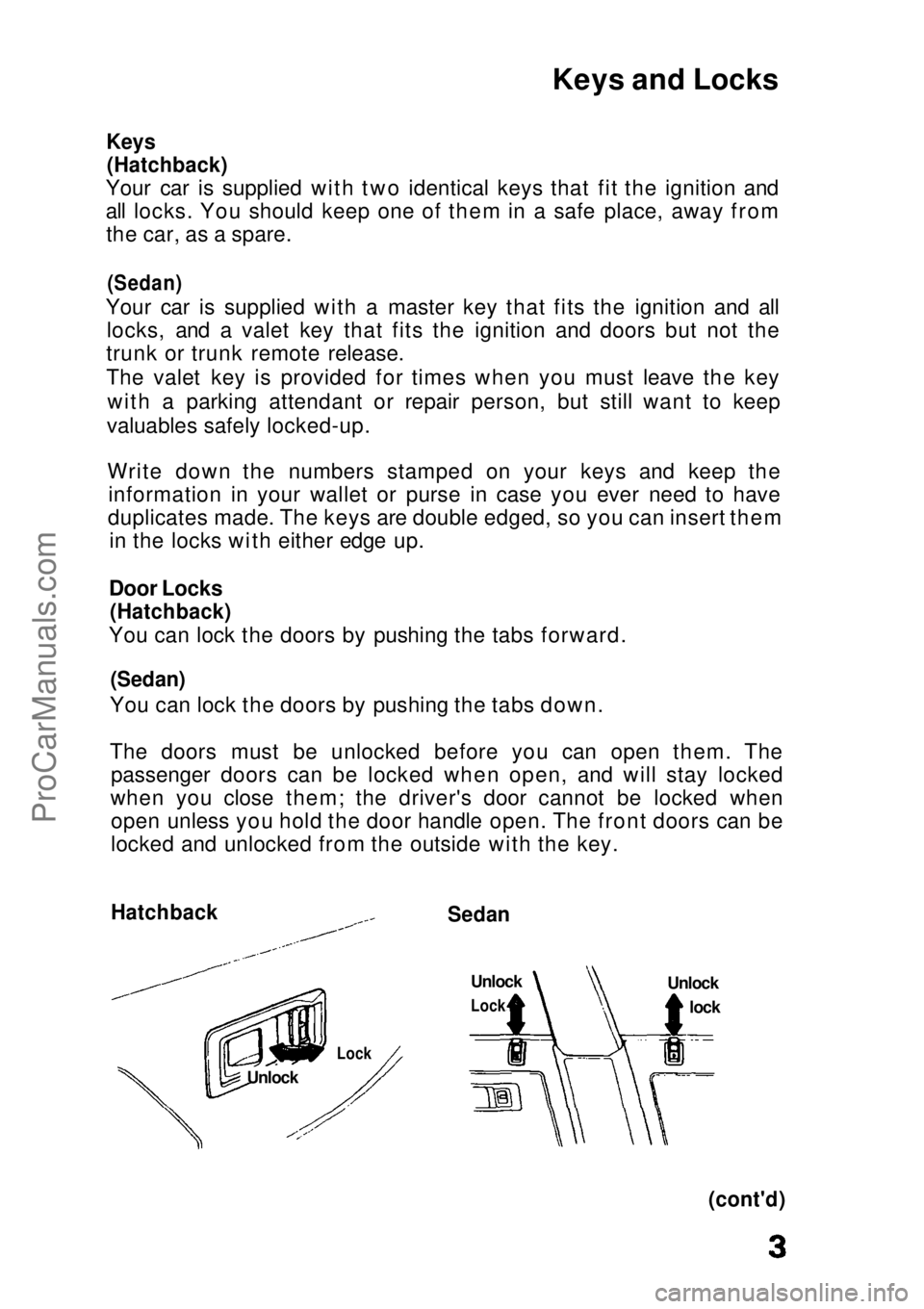
Keys and Locks
Keys (Hatchback)
Your car is supplied with two identical keys that fit the ignition and
all locks. You should keep one of them in a safe place, away from the car, as a spare.
(Sedan)
Your car is supplied with a master key that fits the ignition and all locks, and a valet key that fits the ignition and doors but not the
trunk or trunk remote release.
The valet key is provided for times when you must leave the key
with a parking attendant or repair person, but still want to keep
valuables safely locked-up.
Write down the numbers stamped on your keys and keep the information in your wallet or purse in case you ever need to have
duplicates made. The keys are double edged, so you can insert them in the locks with either edge up.
Door Locks
(Hatchback)
You can lock the doors by pushing the tabs forward.
(Sedan)
You can lock the doors by pushing the tabs down.
The doors must be unlocked before you can open them. The passenger doors can be locked when open, and will stay locked
when you close them; the driver's door cannot be locked when open unless you hold the door handle open. The front doors can be
locked and unlocked from the outside with the key.
(cont'd)
Sedan
Hatchback
Unlock
Lock
Lock
Unlock
lock
UnlockProCarManuals.comMain Menu s t
Page 5 of 136
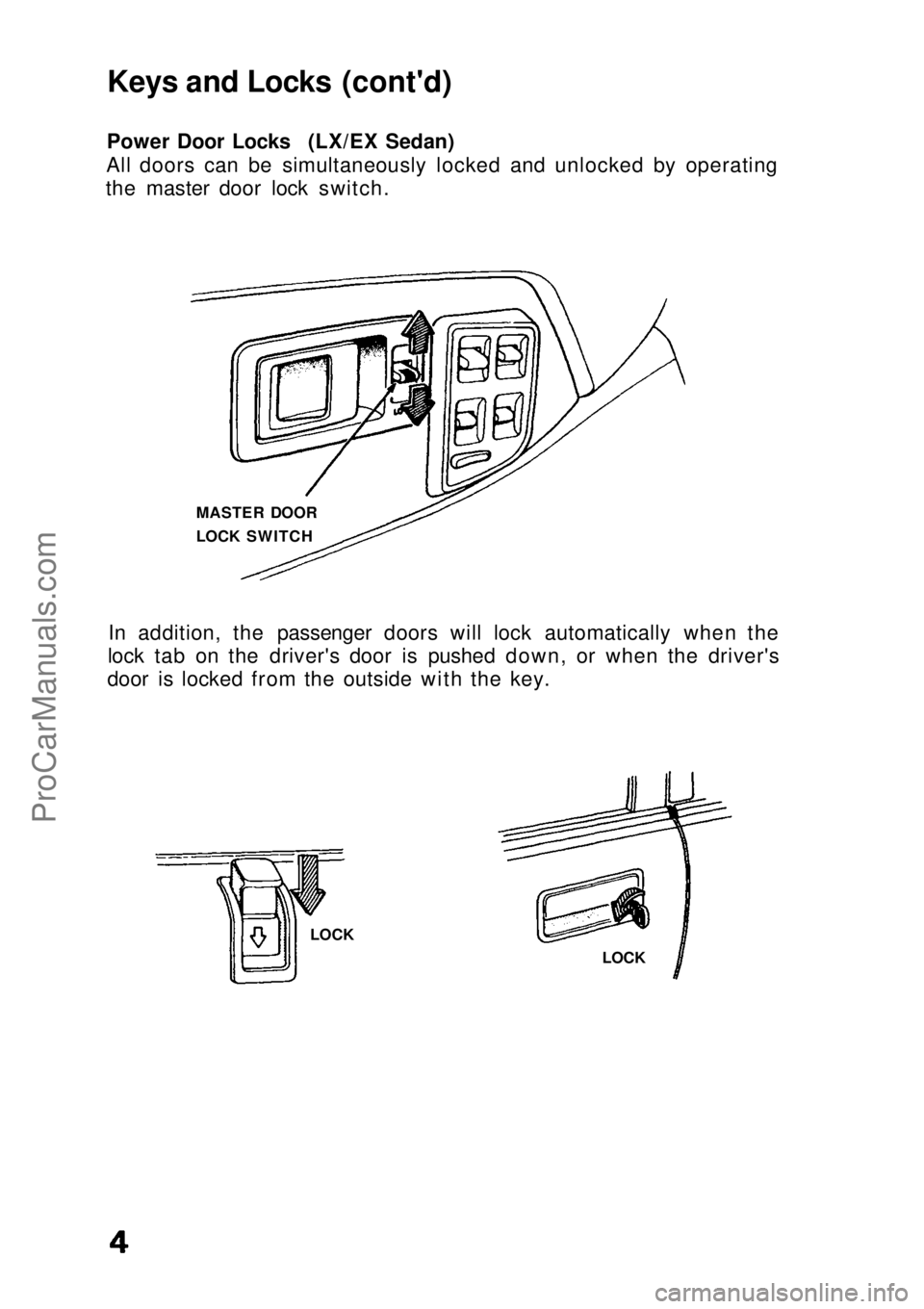
Keys and Locks (cont'd)
Power Door Locks (LX/EX Sedan)
All doors can be simultaneously locked and unlocked by operating
the master door lock switch.
In addition, the passenger doors will lock automatically when the
lock tab on the driver's door is pushed down, or when the driver's
door is locked from the outside with the key. MASTER DOOR
LOCK SWITCH
LOCK LOCKProCarManuals.comMain Menu s t
Page 6 of 136
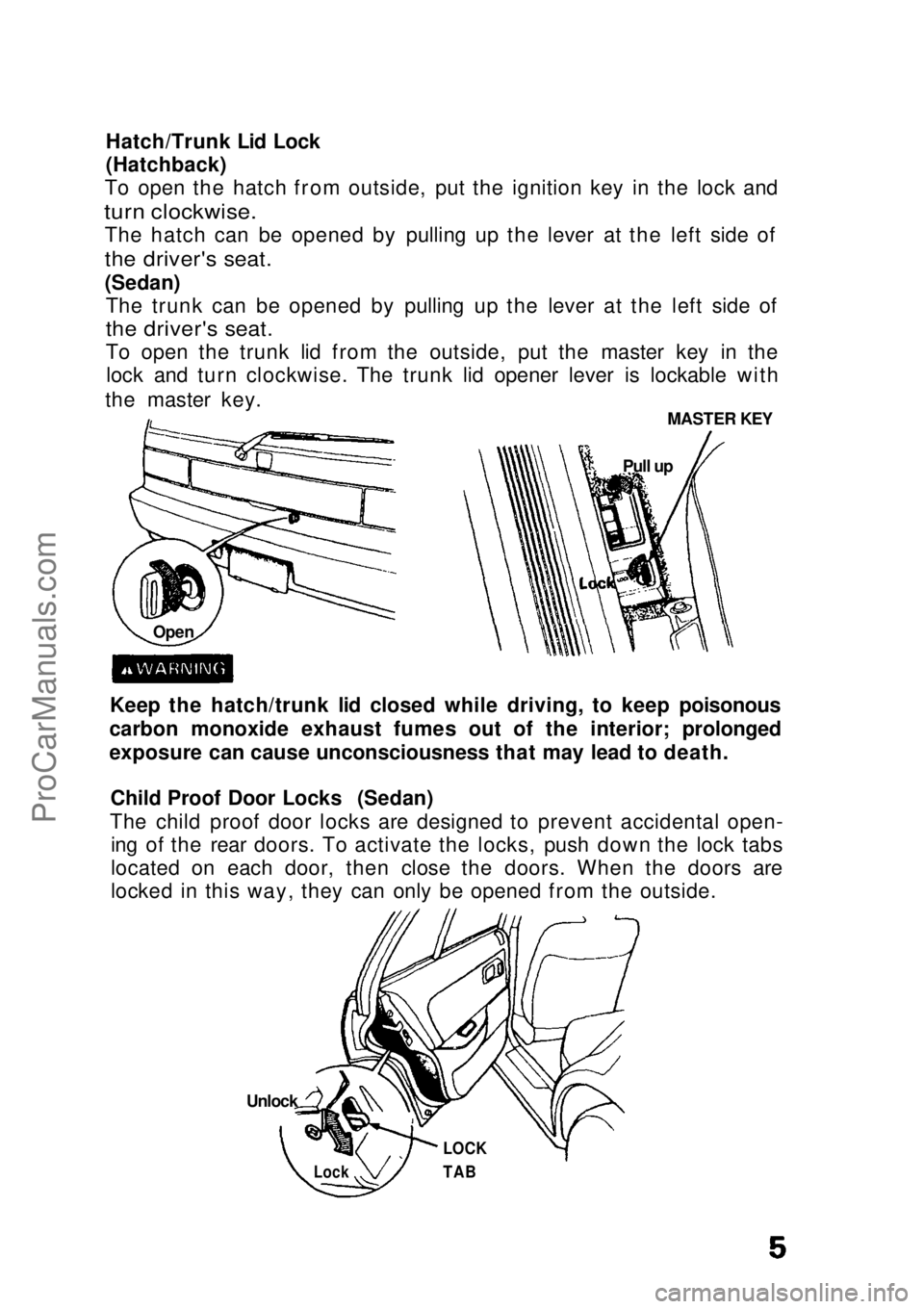
Hatch/Trunk Lid Lock
(Hatchback)
To open the hatch from outside, put the ignition key in the lock and
turn clockwise.
The hatch can be opened by pulling up the lever at the left side of
the driver's seat.
(Sedan) The trunk can be opened by pulling up the lever at the left side of
the driver's seat.
To open the trunk lid from the outside, put the master key in thelock and turn clockwise. The trunk lid opener lever is lockable with
the master key.
Keep the hatch/trunk lid closed while driving, to keep poisonous
carbon monoxide exhaust fumes out of the interior; prolonged
exposure can cause unconsciousness that may lead to death.
Child Proof Door Locks (Sedan)
The child proof door locks are designed to prevent accidental open- ing of the rear doors. To activate the locks, push down the lock tabs
located on each door, then close the doors. When the doors are
locked in this way, they can only be opened from the outside. Open
Unlock
LOCK
TAB
Lock
MASTER KEY
Pull upProCarManuals.comMain Menu s t
Page 9 of 136
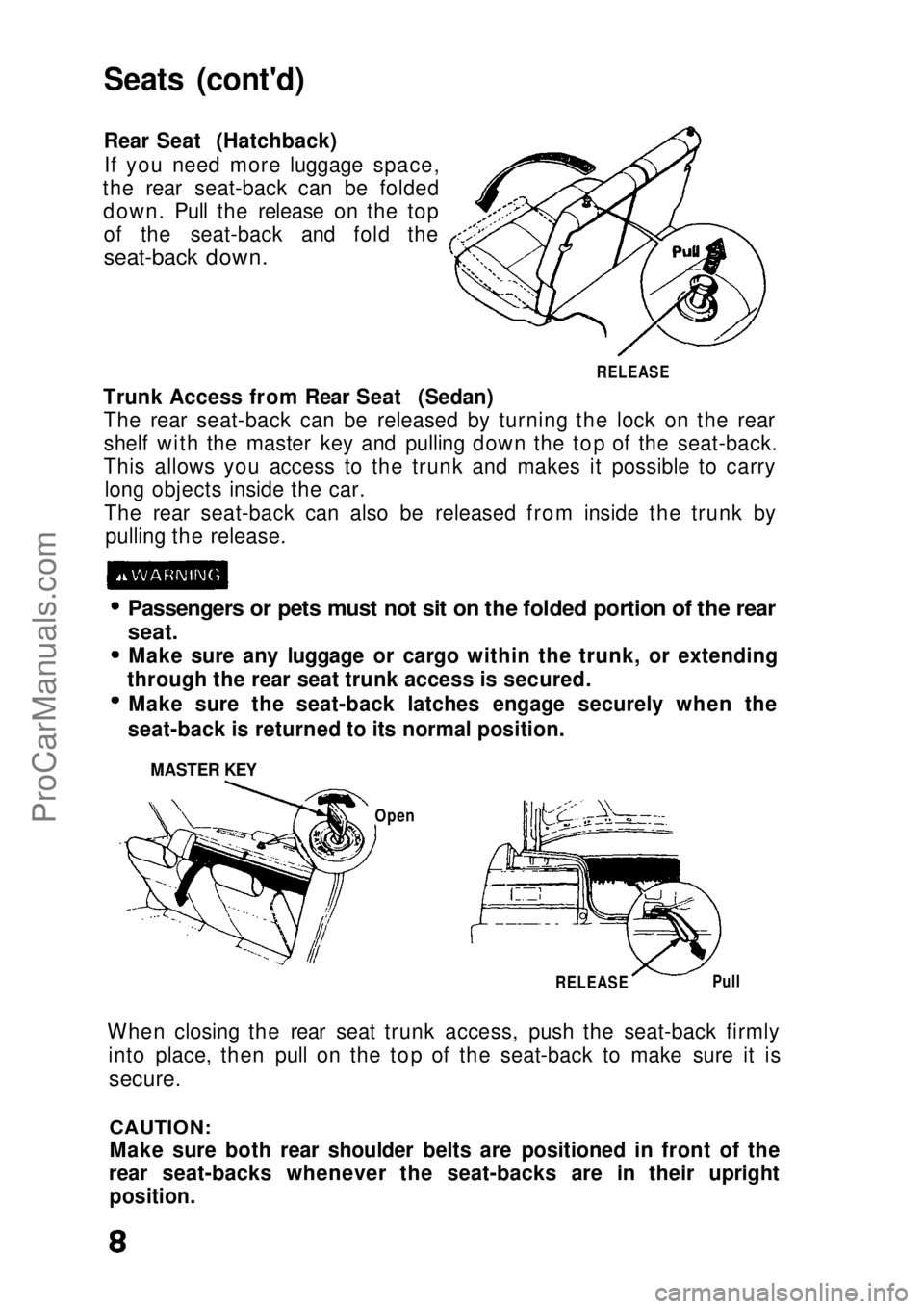
Seats (cont'd)
Rear Seat (Hatchback)
If you need more luggage space,
the rear seat-back can be folded down. Pull the release on the topof the seat-back and fold the
seat-back down.
Trunk Access from Rear Seat (Sedan) The rear seat-back can be released by turning the lock on the rear
shelf with the master key and pulling down the top of the seat-back.
This allows you access to the trunk and makes it possible to carry long objects inside the car.
The rear seat-back can also be released from inside the trunk by pulling the release.
Passengers or pets must not sit on the folded portion of the rear
seat.
Make sure any luggage or cargo within the trunk, or extending
through the rear seat trunk access is secured.
Make sure the seat-back latches engage securely when the
seat-back is returned to its normal position.
When closing the rear seat trunk access, push the seat-back firmly into place, then pull on the top of the seat-back to make sure it is
secure.
CAUTION:
Make sure both rear shoulder belts are positioned in front of the
rear seat-backs whenever the seat-backs are in their upright
position.
MASTER KEY
Open
RELEASE
Pull
RELEASEProCarManuals.comMain Menu s t
Page 13 of 136
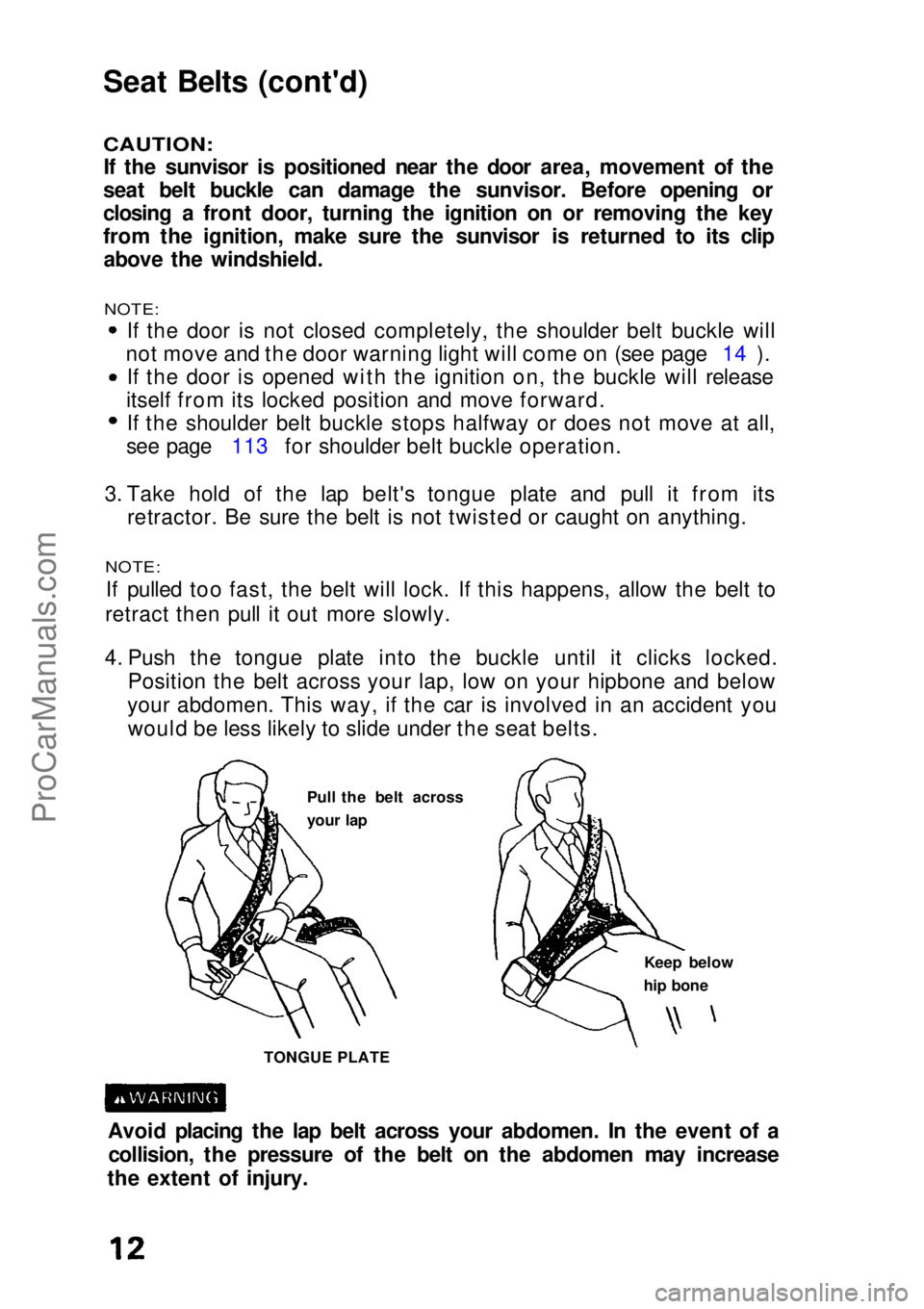
Seat Belts (cont'd)
CAUTION:
If the sunvisor is positioned near the door area, movement of the
seat belt buckle can damage the sunvisor. Before opening or
closing a front door, turning the ignition on or removing the key
from the ignition, make sure the sunvisor is returned to its clip above the windshield.
NOTE:
If the door is not closed completely, the shoulder belt buckle will
not move and the door warning light will come on (see page 14 ). If the door is opened with the ignition on, the buckle will release
itself from its locked position and move forward. If the shoulder belt buckle stops halfway or does not move at all,
see page 113 for shoulder belt buckle operation.
3. Take hold of the lap belt's tongue plate and pull it from its retractor. Be sure the belt is not twisted or caught on anything.
NOTE:
If pulled too fast, the belt will lock. If this happens, allow the belt to
retract then pull it out more slowly.
4. Push the tongue plate into the buckle until it clicks locked. Position the belt across your lap, low on your hipbone and below
your abdomen. This way, if the car is involved in an accident you would be less likely to slide under the seat belts.
Avoid placing the lap belt across your abdomen. In the event of a collision, the pressure of the belt on the abdomen may increase
the extent of injury. Pull the belt across
your lap
Keep below
hip bone
TONGUE PLATEProCarManuals.comMain Menu s t
Page 14 of 136

Never use one belt for more than one person, child or adult.
Comfort clips sold on the open market are not recommended
since they could impair the function and safety of the belts. Make sure the strap of the shoulder belt and the lap belt are not
crossed.
Do not wear the shoulder portion of the belt under your arm or
out of position. Such use could increase the chance and amount
of injury in an accident.
Releasing the Seat Belts
1.To release the manual lap belt, push the "PRESS" button in the buckle, the belt should retract automatically when released.
2. The driver's shoulder belt buckle will release and travel to its off
position when the key is removed from the ignition.
3. The shoulder belt buckle will also release and travel to its off position when the door is opened.
Emergency Belt Release
The shoulder belt should always re- main buckled. In case of an emergen-
cy, however, the shoulder belt can
be released from the shoulder belt
buckle by pushing the button.
Relatch the shoulder belt before operating the car, making sure the
belt is not twisted.
Driving with a twisted seat belt can increase your chance and
extent of injury during a collision. Be sure the shoulder belt is not
twisted before driving the car. Push
(cont'd)ProCarManuals.comMain Menu s t
Page 58 of 136
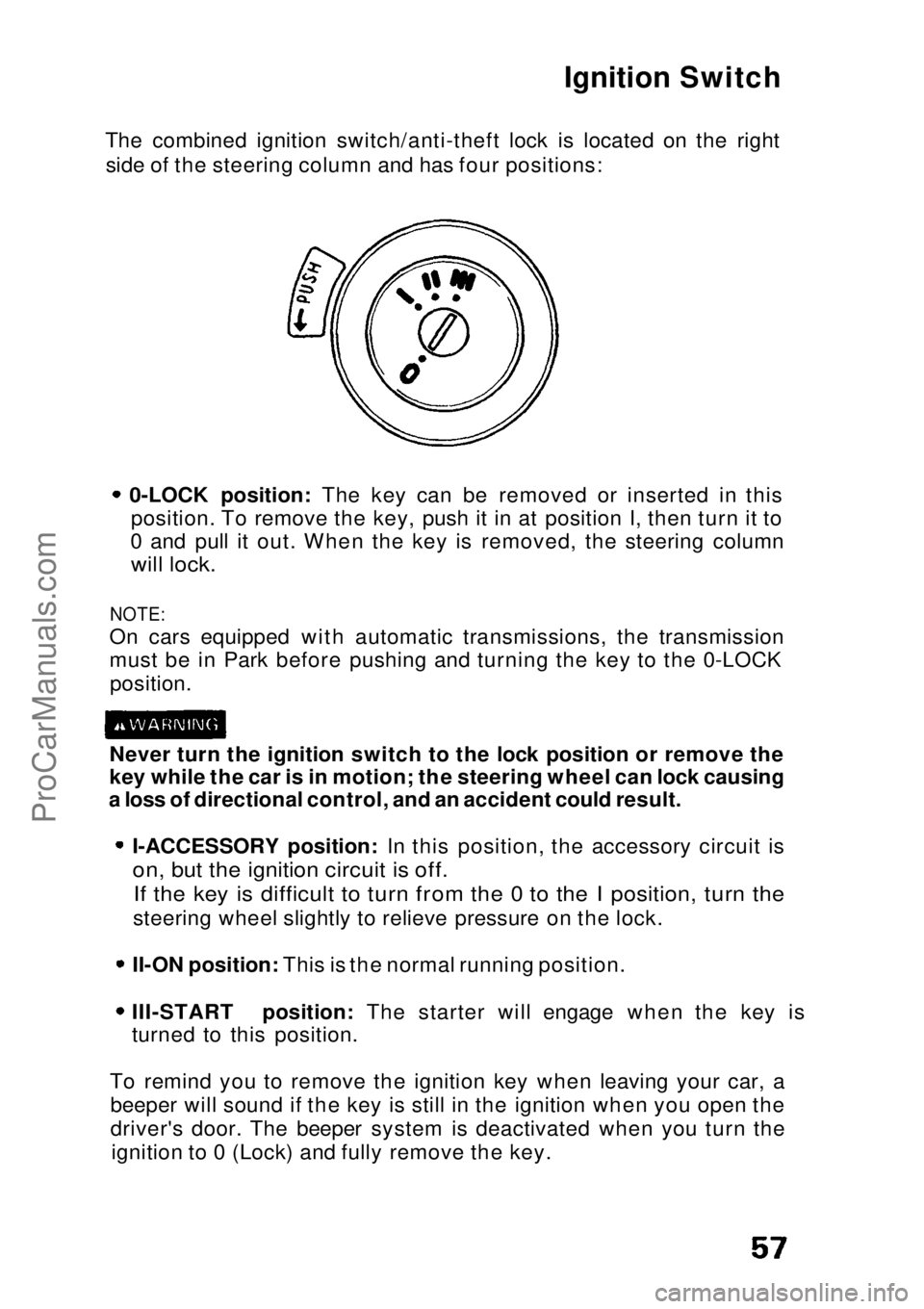
Ignition Switch
The combined ignition switch/anti-theft lock is located on the right side of the steering column and has four positions: 0-LOCK position: The key can be removed or inserted in this
position. To remove the key, push it in at position I, then turn it to
0 and pull it out. When the key is removed, the steering column
will lock.
NOTE:
On cars equipped with automatic transmissions, the transmission
must be in Park before pushing and turning the key to the 0-LOCK
position.
Never turn the ignition switch to the lock position or remove the
key while the car is in motion; the steering wheel can lock causing
a loss of directional control, and an accident could result. I-ACCESSORY position: In this position, the accessory circuit is
on, but the ignition circuit is off.
If the key is difficult to turn from the 0 to the I position, turn the
steering wheel slightly to relieve pressure on the lock. II-ON position: This is the normal running position.
III-START position: The starter will engage when the key is
turned to this position.
To remind you to remove the ignition key when leaving your car, a beeper will sound if the key is still in the ignition when you open the
driver's door. The beeper system is deactivated when you turn the ignition to 0 (Lock) and fully remove the key.ProCarManuals.comMain Menu s t
Page 59 of 136

Starting the Engine
Before Starting
Manual Transmission:
1. Apply the parking brake.
2. Push the clutch pedal all the way in (see NOTE below). 3. Shift the transmission to neutral.
NOTE:
On cars equipped with manual transmissions, the engine will not
crank unless the clutch pedal is fully depressed.
Automatic Transmission:
1. Make sure the shift lever is in Park (P).
2. Apply the parking brake and the foot brake.
NOTE:
When starting in cold weather, keep all unnecessary electrical
circuits off (lights, defogger, etc.) for the best battery output.
Do not crank the engine for more than 15 seconds at a time. Wait
10 seconds before going to the next step.
Starting the Engine 1. With your foot off the accelerator start the engine by turning the key to the III position.
2. If the engine won't start within 15 seconds or starts but fails to continue to run, push the accelerator pedal halfway, and hold it
there while cranking the engine. Once the engine starts, release
the accelerator gradually as the engine speeds up.
3. If it doesn't start within 15 seconds, push the accelerator pedal down to the floor and hold it there while cranking in order to clearflooding. Try step 2 again.
Cold Weather at High Altitude Starting 1. When starting in cold weather at high altitude (above 8,000 feet), push the accelerator pedal about halfway and hold it there while
cranking the engine. Once the engine starts, release the accelerator gradually as the engine speeds up.
2. If it doesn't start within 15 seconds, push the accelerator pedal down to the floor and hold it there while cranking in order to clearflooding. Try step 1 again.
NOTE:
If the outside temperature is below freezing, or if your car has not
been driven for several days, warm up the engine for a few minutes
before driving.ProCarManuals.comMain Menu s t